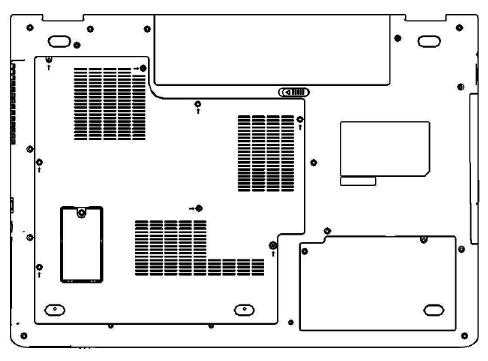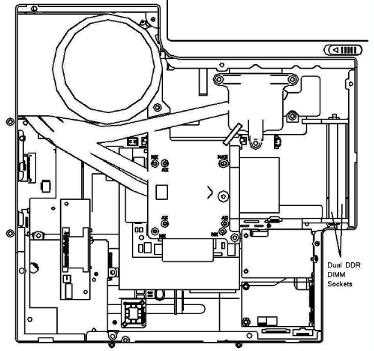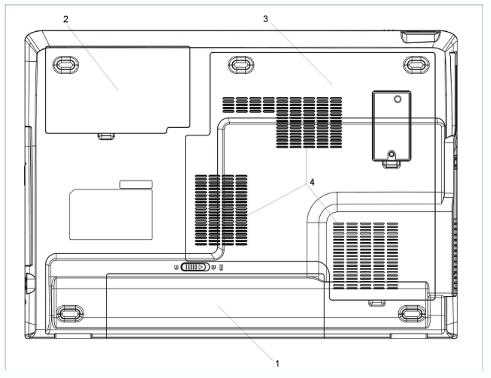 Acer File Extensions |
Advent 7116 Laptop
Specification
| CPU | Intel Core 2 Duo T5200 (1.60GHz) |
| BIOS | AMI BIOS. Press F2 to enter |
| Chipset | Mobile Intel 945PM Express |
| Memory | 1GB DDR2 533MHz PC2-4200 SODIMM (2 memory slots. Max 2GB) |
| Hard Drive | 100GB Toshiba MK1032GSX |
| CD Drive | Lite-on Slimtype DVDRW SSW-8015S |
| Screen | 17" TruBrite TFT (1440x900) |
| Video Card | ATi Mobility Radeon X1600 256MB (up to 512MB) |
| Sound Card | Realtek ALC High Definition Audio |
| Modem | Motorola SM56 |
| Network Card | Marvell Yukon 88E8056 PCI-E Gigabit Ethernet Controller (onboard) Intel Pro 3945ABG Wireless LAN * Toshiba Bluetooth |
| Ports | 1x 4-in-1 Card Reader (supports MMC, SD, MS, and MS Pro cards) 1x LAN 1x Microphone 1x Headphone 1x ExpressCard Slot 1x 4-pin IEEE1394 (FireWire) 3x USB 2.0 1x S-Video TV-Out 1x Modem 1x VGA 1x Kensington Lock |
| Touchpad | Synaptics Touchpad |
| Power Supply | Lite-On PA-1700-02 |
| Dimensions | 35.33 x 402 x 285.5 (HxWxD in mm) |
| Weight | 3.1kg |
| Made By | Uniwill X72IA5 |
* Use switch on front of laptop to turn wireless on/off.
Drivers
Your laptop should have been supplied with a "Notebook Utility CD" which contains a copy of the drivers and user manual.
Memory Upgrades
The memory slots are accessed by removing the System Device Cover underneath. To install the DIMM under the System Device Cover, do the following:
- Power OFF the notebook. Unplug the AC cord and all cables/devices attached to the notebook. Remove the battery
- Place your hand on a large metal object momentarily to discharge any static electricity. Place the notebook on a flat surface and fully close the LCD lid
- Locate and remove 8 Screw Dís on the System Device Cover

- Remove the System Device Cover. The DIMM socket is now seen as shown below

- If you need to remove an old DIMM from the socket, press out on the latches located on both edges of the socket at the same time. The DIMM should pop up to an angle of 30 degree. Pull the DIMM module out of the memory socket. Store away the DIMM for the future use
- Install the new DIMM module into the memory socket. The DIMM will only fit in one orientation. Insert the DIMM at an angle of approximately 30 degrees into the empty memory socket. Then press it firmly so that the contact edge is driven into the receiving socket
- Pivot the DIMM until the latches on both sides of the socket snap into place
- Put the System Device Cover back and tighten the screws
Bottom of Laptop

- Battery Pack and Battery Latch
- Hard Disk Drive Cover
- System Device Cover
- Ventilation Grill
Function Keys
Fn + F1 - Enters Suspend ModeFn + F3 - Turns the battery warning beep off/on
Fn + F4 - Changes Display Mode: LCD-only, CRT-only, LCD+CRT
Fn + F5 - Turns Speaker Volume up
Fn + F6 - Turns Speaker Volume down
Fn + F7 - Increases Display Brightness
Fn + F8 - Decreases Display Brightness
In the Box
Disks Supplied
- Microsoft Works 8.5
- Notebook Utility CD
- NTI CD Maker CD
Items Supplied
- Advent 7116 notebook
- LiteOn power supply. Output: 19V - 3.42A
- Mains power cable
- UK modem cable
Documentation Supplied
- Advent Safety and Regulations Manual
- Advent Notebook Manual
- Advent Recovery Manual
Recovery Disc
Hard Drive Recovery
Should your Windows develop serious errors or fail to start, you can restore your computer back to factory settings by using the hard drive recovery located on a hidden partition on the hard drive.
To restore your computer back to factory settings, follow the steps below:
- Turn on the computer and keep tapping F8 until the advanced options menu is displayed
- Use the up/down arrow keys on the keyboard to highlight Repair Your Computer and press enter to select it
- Select the language you wish to install (normally English is the only option)
- Once you have chosen your language you will be presented with the available recovery options
- Microsoft Repair Environment - after choosing the UK keyboard layout you will be asked to choose the Operating System you wish to repair. If Windows Vista is not listed then you cannot repair the OS without doing the full recovery. After choosing Vista the Microsoft Vista startup repair tool will run and attempt to repair any startup problems you are experiencing
- Reinstall Windows - gives you the options available to reinstall Vista
- Advanced Options - this launches the diagnostic centre allowing you to run chkdsk, launch notepad or bring up a command prompt
- Exit & restart computer - Exits withut running the recovery process
- To continue with the recovery program you need to choose Reinstall Windows
- On the next screen you have the ability to launch Vista System Restore and roll back to a date when Vista was last working ok or to run the Full Destructive Recovery. To continue with the recovery program you need to choose Start Full Destructive Recovery
- After choosing the Full Destructive Recovery option you are presented with the warning screen that all data will be lost. It is important to make sure all data has been backed up to disk if possible and to realise this process deletes all data and reverts the machine back to it's default state. To continue with the recovery program you need to tick the box indicating you are aware of data loss
- The recovery process will then run through, the computer will restart a couple of times during this. You will also need to go through the Vista "Out of Box Experience", to configure Vista. This is fairly straightforward so just follow the onscreen instructions
Recovery DVD Creator
Your computer comes supplied with a hard drive based recovery allowing you to reinstall Windows Vista very easily should the need arise. You also have the ability to create a recovery DVD which is recommended on all machines. To create a recovery DVD (note - you cannot use CDs) do the following.
- Double click on the Techguys DVD icon on the desktop or from the start menu
- The first screen will prompt you to insert a DVD into your drive. Click OK.
- On the next screen make sure your DVD drive is selected in the 'To' field. To reduce the risk of errors ensure the write speed is set to the lowest value and tick verify recorded data. Click Burn
- Once the process has completed, label your DVD, keep it in a safe place and in a protective case to avoid damage
DVD Recovery
Should your Windows develop serious errors or fail to start, you can restore your computer back to factory settings by using the Recovery DVD you may have created or been sent.
To restore your computer back to factory settings, follow the steps below.
- Start the computer with the Recovery DVD in the optical disc drive
- After the usual startup screen has vanished press a key when prompted to load from the DVD
- Select the language you wish to install (normally English is the only option)
- Once you have chosen your language you will be presented with the available recovery options
- Microsoft Repair Environment - after choosing the UK keyboard layout you will be asked to choose the Operating System you wish to repair. If Windows Vista is not listed then you cannot repair the OS without doing the full recovery. After choosing Vista the Microsoft Vista startup repair tool will run and attempt to repair any startup problems you are experiencing
- Reinstall Windows - gives you the options available to reinstall Vista
- Advanced Options - this launches the diagnostic centre allowing you to run chkdsk, launch notepad or bring up a command prompt
- Exit & restart computer - Exits withut running the recovery process
- To continue with the recovery program you need to choose Reinstall Windows
- On the next screen you have the ability to launch Vista System Restore and roll back to a date when Vista was last working ok or to run the Full Destructive Recovery. To continue with the recovery program you need to choose Start Full Destructive Recovery
- After choosing the Full Destructive Recovery option you are presented with the warning screen that all data will be lost. It is important to make sure all data has been backed up to disk if possible and to realise this process deletes all data and reverts the machine back to it's default state. To continue with the recovery program you need to tick the box indicating you are aware of data loss
- The recovery process will then run through, reinstalling Vista and also recreating the hard drive recovery system for future use.
- When it has finished copying files it will ask you to remove the DVD and then restart the computer. It will then go through setting up Vista, you will need to go through the Vista "Out of Box Experience". This is fairly straightforward so just follow the onscreen instructions